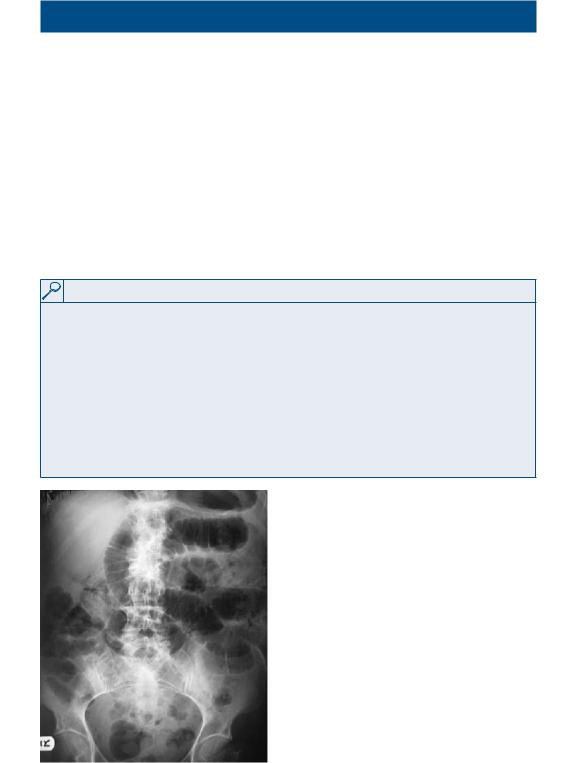
- •CONTENTS
- •PREFACE
- •ABBREVIATIONS
- •GENERAL AND COLORECTAL
- •CASE 1:
- •ANSWER 1
- •CASE 2:
- •ANSWER 2
- •CASE 3:
- •ANSWER 3
- •CASE 4:
- •ANSWER 4
- •CASE 5:
- •ANSWER 5
- •CASE 6:
- •ANSWER 6
- •CASE 7:
- •ANSWER 7
- •CASE 8:
- •ANSWER 8
- •CASE 9:
- •ANSWER 9
- •CASE 10:
- •ANSWER 10
- •CASE 11:
- •ANSWER 11
- •CASE 12:
- •ANSWER 12
- •CASE 13:
- •ANSWER 13
- •CASE 14:
- •ANSWER 14
- •CASE 15:
- •ANSWER 15
- •CASE 16:
- •ANSWER 16
- •CASE 17:
- •ANSWER 17
- •CASE 18:
- •ANSWER 18
- •CASE 19:
- •ANSWER 19
- •CASE 20:
- •ANSWER 20
- •UPPER GASTROINTESTINAL
- •CASE 21:
- •ANSWER 21
- •CASE 22:
- •ANSWER 22
- •CASE 23:
- •ANSWER 23
- •CASE 24:
- •ANSWER 24
- •CASE 25:
- •ANSWER 25
- •CASE 26:
- •ANSWER 26
- •CASE 27:
- •ANSWER 27
- •CASE 28:
- •ANSWER 28
- •CASE 29:
- •ANSWER 29
- •CASE 30:
- •ANSWER 30
- •CASE 31:
- •ANSWER 31
- •CASE 32:
- •ANSWER 32
- •CASE 33:
- •ANSWER 33
- •CASE 34:
- •ANSWER 34
- •CASE 35:
- •ANSWER 35
- •CASE 36:
- •ANSWER 36
- •BREAST AND ENDOCRINE
- •CASE 37:
- •ANSWER 37
- •CASE 38:
- •ANSWER 38
- •CASE 39:
- •ANSWER 39
- •CASE 40:
- •ANSWER 40
- •CASE 41:
- •VASCULAR
- •CASE 42:
- •ANSWER 42
- •CASE 43:
- •ANSWER 43
- •CASE 44:
- •ANSWER 44
- •CASE 45:
- •ANSWER 45
- •CASE 46:
- •ANSWER 46
- •CASE 47:
- •ANSWER 47
- •CASE 48:
- •ANSWER 48
- •CASE 49:
- •ANSWER 49
- •CASE 50:
- •ANSWER 50
- •CASE 51:
- •ANSWER 51
- •CASE 52:
- •ANSWER 52
- •CASE 53:
- •ANSWER 53
- •CASE 54:
- •ANSWER 54
- •CASE 55:
- •ANSWER 55
- •CASE 56:
- •ANSWER 56
- •UROLOGY
- •CASE 57:
- •ANSWER 57
- •CASE 58:
- •ANSWER 58
- •CASE 59:
- •ANSWER 59
- •CASE 60:
- •ANSWER 60
- •CASE 61:
- •ANSWER 61
- •CASE 62:
- •ANSWER 62
- •CASE 63:
- •ANSWER 63
- •CASE 64:
- •ANSWER 64
- •ORTHOPAEDIC
- •CASE 65:
- •ANSWER 65
- •CASE 66:
- •ANSWER 66
- •CASE 67:
- •ANSWER 67
- •CASE 68:
- •ANSWER 68
- •CASE 69:
- •Questions
- •ANSWER 69
- •CASE 70:
- •ANSWER 70
- •CASE 71:
- •ANSWER 71
- •CASE 72:
- •ANSWER 72
- •CASE 73:
- •ANSWER 73
- •CASE 74:
- •ANSWER 74
- •CASE 75:
- •ANSWER 75
- •CASE 76:
- •ANSWER 76
- •CASE 77:
- •ANSWER 77
- •CASE 78:
- •ANSWER 78
- •CASE 79:
- •ANSWER 79
- •CASE 80:
- •ANSWER 80
- •CASE 81:
- •ANSWER 81
- •EAR, NOSE AND THROAT
- •CASE 82:
- •ANSWER 82
- •CASE 83:
- •ANSWER 83
- •CASE 84:
- •ANSWER 84
- •CASE 85:
- •ANSWER 85
- •NEUROSuRGERY
- •CASE 86:
- •ANSWER 86
- •CASE 87:
- •ANSWER 87
- •CASE 88:
- •ANSWER 88
- •CASE 89:
- •ANSWER 89
- •ANAESTHESIA
- •CASE 90:
- •ANSWER 90
- •CASE 91:
- •ANSWER 91
- •CASE 92:
- •ANSWER 92
- •CASE 93:
- •ANSWER 93
- •CASE 94:
- •ANSWER 94
- •POSTOPERATIVE COMPLICATIONS
- •CASE 95:
- •ANSWER 95
- •CASE 96:
- •ANSWER 96
- •CASE 97:
- •ANSWER 97
- •CASE 98:
- •ANSWER 98
- •CASE 99:
- •ANSWER 99
- •CASE 100:
- •ANSWER 100

GENERAL AND COLORECTAL
CASE 1: a lump in the groin
history
A 51-year-old woman presents to the emergency department with a painful right groin. She reports lower abdominal distension and has vomited twice on the way to the hospital. She has passed flatus but has not opened her bowels since yesterday. She is otherwise fit and well and is a non-smoker. She lives with her husband and four children.
examination
On examination she appears unwell. Her blood pressure is 106/70 mmHg and the pulse rate is 108/min. She is febrile with a temperature of 38.0°C. The abdomen is tender, particularly in the right iliac fossa, and there is marked lower abdominal distension. There is a small swelling in the right groin, which is originating below and lateral to the pubic tubercle. The lump is irreducible and no cough impulse is present. Digital rectal examination is unremarkable and bowel sounds are hyperactive.
INVESTIGATIONS
|
|
Normal |
haemoglobin |
14.1 g/dl |
11.5–16.0 g/dl |
White cell count |
18.0 × 109/l |
4.0–11.0 × 109/l |
platelets |
361 × 109/l |
150–400 × 109/l |
Sodium |
133 mmol/l |
135–145 mmol/l |
potassium |
3.3 mmol/l |
3.5–5.0 mmol/l |
urea |
6.1 mmol/l |
2.5–6.7 mmol/l |
Creatinine |
63 μmol/l |
44–80 μmol/l |
amylase |
75 iu/l |
0–99 iu/l |
an x-ray of the abdomen is performed and is shown in Figure 1.1.
Questions
• |
What is the cause of the x-ray |
|
appearances? |
• |
What is the swelling? |
• |
What are the anatomical |
|
boundaries? |
• |
What is the initial treatment in |
|
this case? |
• |
What is the differential diagnosis |
|
for a lump in the groin region? |
Figure 1.1 plain x-ray of the abdomen.
1

100 Cases in Surgery
ANSWER 1
This woman has a right-sided femoral hernia. The neck of the femoral hernia lies below and lateral to the pubic tubercle, differentiating it from an inguinal hernia, which lies above and medial to the pubic tubercle. The x-ray shows small-bowel dilation as a result of obstruction due to trapped small bowel in the hernia sac. The high white cell count, temperature and tenderness may indicate strangulation of the hernia contents. The rigid borders of the femoral canal make strangulation more likely than in inguinal hernias.
!Relations of the femoral canal
•Anteriorly: inguinal ligament
•Posteriorly: superior ramus of the pubis and pectineus muscle
•Medially: body of pubis, pubic part of the inguinal ligament
•Laterally: femoral vein
The patient should be kept nil by mouth, and intravenous fluids and antibiotics begun. A nasogastric tube should be passed and bloods taken in preparation for theatre. Theatres should then be informed and the patient taken for urgent surgery to reduce and repair the hernia, with careful inspection of the hernial sac contents. If the bowel is infarcted, it will need to be resected.
!Differential diagnosis for a lump in the groin
•inguinal hernia
•Femoral hernia
•hydrocoele of the cord
•hydrocoele of the canal of nuck
•lipoma of the cord
•undescended testicle
•ectopic testicle
•Saphena varix
•iliofemoral aneurysm
•lymph nodes
•psoas abscess
KEY POINTS
•Femoral hernias are at high risk of strangulation.
•if strangulation is suspected, urgent surgical correction is required.
2

General and Colorectal
CASE 2: right iliaC FoSSa pain
history
A 19-year-old man presents with a 2-day history of abdominal pain. The pain started in the central abdomen and has now become constant and has shifted to the right iliac fossa. The patient has vomited twice today and is off his food. His motions were loose today, but there was no associated rectal bleeding.
examination
The patient has a temperature of 37.8°C and a pulse rate of 110/min. On examination of his abdomen, he has localized tenderness and guarding in the right iliac fossa. Urinalysis is clear.
INVESTIGATIONS
|
|
Normal |
haemoglobin |
14.2 g/dl |
11.5–16.0 g/dl |
mean cell volume |
86 fl |
76–96 fl |
White cell count |
19 × 109/l |
4.0–11.0 × 109/l |
platelets |
250 × 109/l |
150–400 × 109/l |
Sodium |
136 mmol/l |
135–145 mmol/l |
potassium |
3.5 mmol/l |
3.5–5.0 mmol/l |
urea |
5.0 mmol/l |
2.5–6.7 mmol/l |
Creatinine |
62 μmol/l |
44–80 μmol/l |
C-reactive protein (Crp) |
20 mg/l |
<5 mg/l |
Questions
•What is the likely diagnosis?
•What are the differential diagnoses for this condition?
•How would you manage this patient?
•What are the complications of any surgical intervention that may be required?
3

100 Cases in Surgery
ANSWER 2
The history and the findings on examination strongly suggest acute appendicitis.
!Differential diagnoses of acute appendicitis
•mmesenteric adenitis
•psoas abscess
•meckel’s diverticulitis
•Crohn’s ileitis
•non-specific abdominal pain
and additionally in females:
•ovarian cyst rupture
•ovarian torsion
•ectopic pregnancy (all females must have a pregnancy test)
The treatment is appendicectomy. The patient should be rehydrated with preoperative intravenous fluids, and receive analgesia. Antibiotics should be given if the diagnosis is clear and the decision for surgery has been made. Surgery should be carried out promptly in a patient who has signs of peritonitis, in order to avoid systemic toxicity. The appendix can be removed by open operation or laparoscopically.
!Complications
•Wound infection: reduced by using broad-spectrum antibiotics
•intra-abdominal collections and pelvic abscesses
•prolonged ileus
•Fistulation between the appendix stump and the wound
•Deep vein thrombosis, pulmonary embolism, pneumonia, atelectasis
•late complications: incisional hernia, adhesional obstruction
KEY POINT
•if the appendix is normal at the time of the operation, the small bowel should be inspected for the presence of a meckel’s diverticulum.
4
